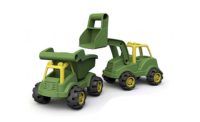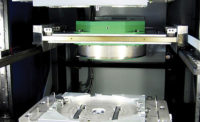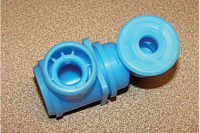There are quite a few options for welding plastic parts, including ultrasonics, laser, hot plate and radio frequency. Additionally, parts can be mechanically joined via fasteners, snap fits or adhesives. Each of these processes has certain advantages and disadvantages for production, and each requires vastly different part and joint designs. Therefore, it’s important to determine which joining method is best for the application before finalizing the part design.
There are several factors to consider when deciding on a joining process. Some of the most significant factors are part size, joint strength, cosmetic requirements, material choice and production rate. Once the choice has been narrowed down to a few processes, it is usually helpful to consult a welding or joining expert to review the preliminary part design for anything that might prevent use of a particular process.
It’s important to note that only thermoplastic polymers can be welded, not thermosets. Additionally, it is usually not possible to weld dissimilar plastics, although they can sometimes be mechanically bonded with a welding process. Using the same material for both parts will generally result in a larger processing window and a stronger weld. On the other hand, fasteners, snap fits and adhesives offer much more flexibility on material choice.
Mechanical and Chemical Joining
The chief advantage of fasteners is that they enable the parts to be disassembled for service, repair or recycling. The right fastener is critical. Engineers should choose a fastener designed specifically for plastics. Compared with the threads of standard screws, the threads on screws for plastics are more widely spaced and have a narrower flank angle. As a result, the threads exert less radial stress on the boss, which prevents cracking, and they capture more material, which increases pull-out strength.
The chief advantages of adhesives are that they distribute the load evenly and can provide a tight seal. For adhesive bonding, parts should be designed so the joint is only subjected to shear or compressive stresses. Exposure to cleavage and peel stresses should be minimized. When designing plastic parts for adhesive bonding, the goal is to maximize the surface area for the adhesive to bond to. Ideally, the substrate should fail before the adhesive does.
Snap fits can also join dissimilar materials. But, unlike fastening or bonding, snap fits do not require consumables or assembly equipment. They are assembled quickly and easily, and they can be designed to create permanent or openable joints. Snap-fit assembly is also the most energy-efficient joining method.
Thermal, Friction, and Electromagnetic Welding
Ultrasonic welding, vibration welding and other welding methods share many advantages. Most don’t require consumables or emit gases, such as volatile organic compounds, that need to be vented. They can all produce permanent joints, create hermetic seals, and capture internal components between the parts to be welded.
The differences between the various techniques are subtle. For example, ultrasonic and vibration welding can accommodate some contour in the joint, but for spin welding, the joint must be flat (and circular). Similarly, vibration and spin welding can be used on parts with complex part geometry on both the fixed and mobile parts. Laser and ultrasonic welding, however, require a relatively constant distance between the joint and the top surface of the part through which the light or vibrations are being passed.
Most welding methods can be performed on any thermoplastic material. The exception to this rule is radio frequency welding, for which the material must have dipole molecules. Additionally, for most laser welding processes, at least one of the parts must be transparent to the laser (though it does not necessarily have to be transparent to the eye).
ASSEMBLY ONLINE
For more information on plastic assembly, visit www.assemblymag.com to read these articles:



